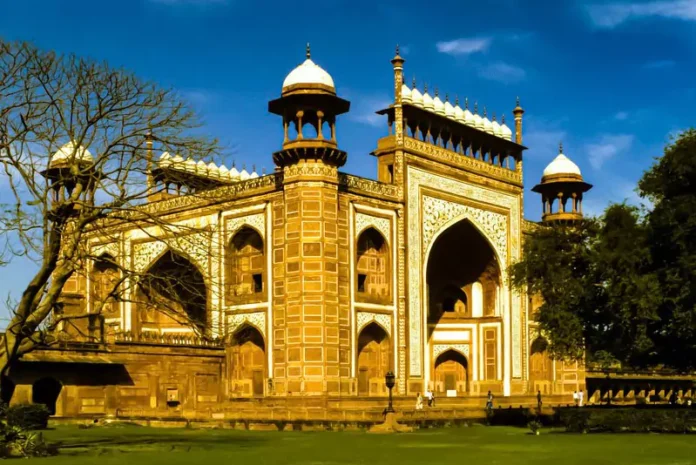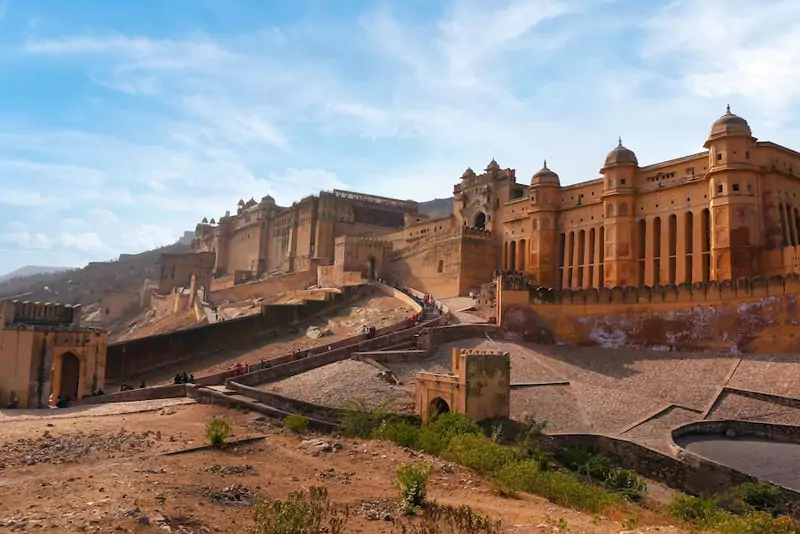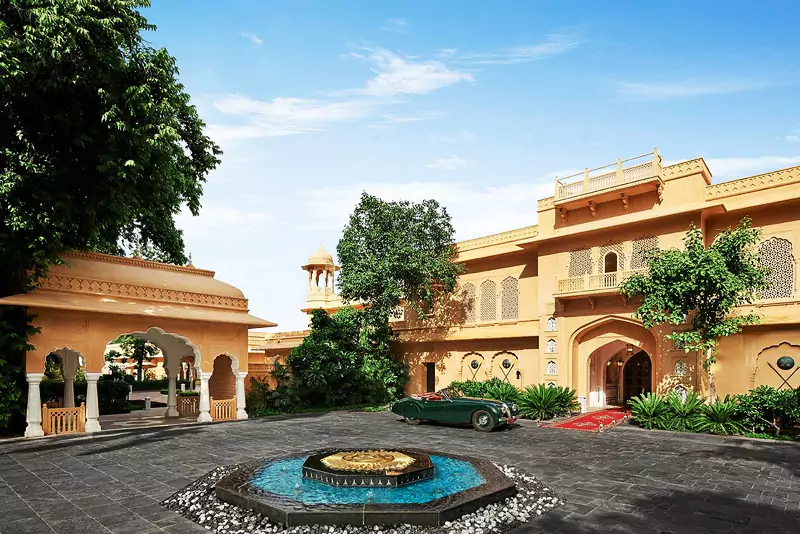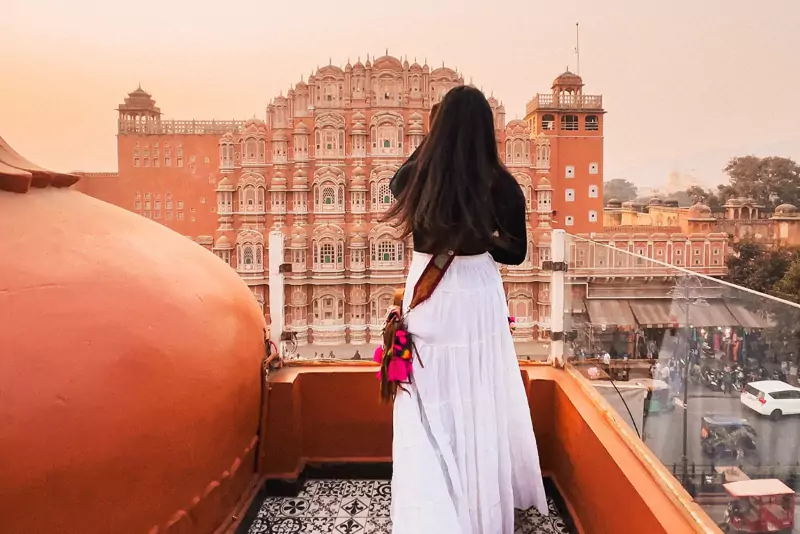Agra: A Journey into a Golden Era
Agra is a city that transports you to an era of grandeur and timeless beauty—a living legacy of a bygone age. Known for its rich heritage and stunning architecture, Agra is dotted with magnificent monuments that echo tales of empires, love, and legends. Its earliest reference appears in the epic Mahabharata as “Agravana,” a Sanskrit word meaning “Paradise.” The Greek geographer Ptolemy was the first to mention it as “Agra” in the 2nd century CE.
The foundations of modern Agra were laid in the 16th century by Sikandar Lodi of the Lodi Dynasty. However, it was under the reign of the Mughal emperor Shah Jahan that Agra truly reached the pinnacle of architectural splendor, gifting the world the eternal symbol of love — the Taj Mahal.
Located on the banks of the Yamuna River in western Uttar Pradesh, Agra is much more than just the home of the Taj. The city is filled with majestic forts, serene tombs, and intricate mausoleums, all waiting to be explored.
Agra is also celebrated for its traditional craftsmanship, including:
- Pietra Dura (marble inlay work)
- Hand-knotted carpets
- Fine leather goods
For lovers of shopping and street food, Agra is nothing short of paradise. And no trip is complete without tasting the city’s iconic sweet – Petha.
Agra offers a rare blend of heritage, artistry, and flavor – creating an enriching and unforgettable experience for every traveler.
Must-Visit Attractions in Agra
Taj Mahal – The Eternal Symbol of Love
Described by Rudyard Kipling as “the embodiment of all things pure”, the Taj Mahal is a timeless tribute to love, beauty, and Mughal architecture. Built in 1631 by Emperor Shah Jahan in memory of his beloved wife Mumtaz Mahal, who died during childbirth, the monument was her final wish — that a tomb unlike any in the world be built in her remembrance.
Crafted entirely from white marble and adorned with exquisite inlay work, the Taj Mahal is not only a UNESCO World Heritage Site but also one of the Seven Wonders of the Modern World — a must-visit for anyone traveling to India.
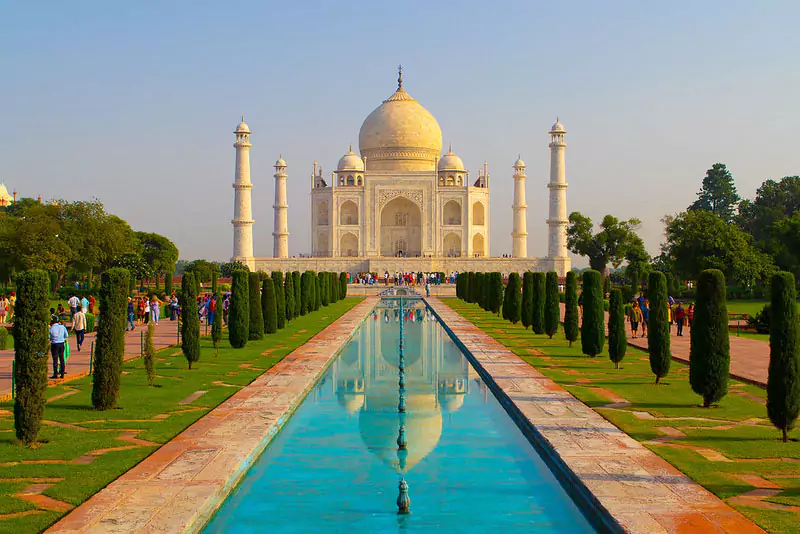
The construction of the Taj Mahal took 17 years, involved over 22,000 artisans, and employed 1,000 elephants to transport materials.
Situated on the banks of the Yamuna River, the Taj Mahal is a UNESCO World Heritage Site and one of the most iconic landmarks in the world. It stands gracefully at the center of a traditional Mughal garden, elevated on a white marble platform with its back facing the river. Perfectly symmetrical from all sides, the monument is adorned with exquisite Pietra Dura inlay work—floral motifs made of semi-precious stones—and beautifully inscribed verses from the Quran carved in jasper.
Even centuries after its creation, the Taj Mahal remains as breathtaking as ever. Its timeless beauty continues to captivate photographers, history lovers, and travelers from around the globe, making it one of the most visited and cherished monuments in India.
Agra Fort: Grandeur of the Mughal Legacy
Located on the banks of the Yamuna River, Agra Fort is a majestic red sandstone fortress that reflects the might and architectural brilliance of the Mughal Empire. Commissioned by Emperor Akbar in 1565, the fort was later transformed and embellished by his grandson, Shah Jahan, to reflect a more refined aesthetic.
Built in a semi-circular layout, the fort is enclosed by massive 21.4-meter-high walls and stretches across a vast area. Originally designed as a military stronghold, a portion of the fort still remains under the control of the Indian Army today.
A UNESCO World Heritage Site, Agra Fort is not just a historical monument but a journey into the rich past of Mughal rule, offering travelers a stunning blend of power, art, and history.
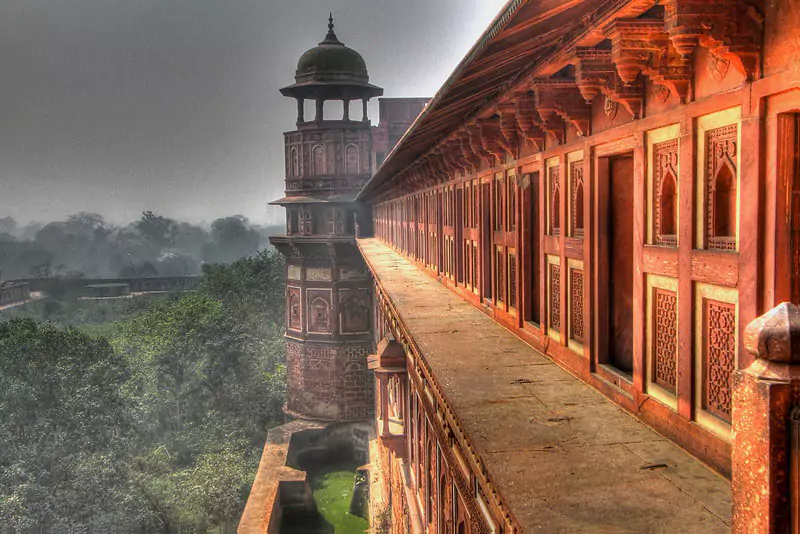
Later, Shah Jahan transformed Agra Fort into a magnificent palace. Ironically, it also became his prison when his son, Aurangzeb, seized power and placed him under house arrest within the fort for the last eight years of his life.
Inside the fort lies a fascinating maze of palaces, halls, and underground chambers. The only entrance open to visitors today is the Amar Singh Gate, which leads directly toward the elegant Moti Masjid (Pearl Mosque). Before reaching it, you’ll pass through the Diwan-i-Am (Hall of Public Audience), where Shah Jahan once addressed the concerns of the common people. Nearby steps lead to a large courtyard and the exquisite Nagina Masjid, a private mosque made of pure white marble.
Other key highlights inside Agra Fort include:
- Diwan-i-Khas – The Hall of Private Audience, once home to the legendary Koh-i-Noor diamond and the Peacock Throne.
- Sheesh Mahal – The stunning Mirror Palace, with intricate glass mosaic work covering the walls.
- Khas Mahal – A beautiful white marble palace with an octagonal tower offering breathtaking views of the Taj Mahal.
- Jahangiri Mahal – A grand red sandstone palace built by Akbar for his son, Jahangir.
Agra Fort is not just a fortress; it’s a living chronicle of Mughal grandeur, political intrigue, and architectural brilliance. A must-visit for history lovers and culture seekers alike.
Sikandra (Tomb of Akbar the Great): A Grand Mausoleum of a Visionary Emperor
Located on the western outskirts of Agra, Sikandra is home to the majestic tomb of Emperor Akbar. This architectural marvel is a striking blend of red sandstone and white marble. Construction of the tomb was initiated by Akbar himself and later completed by his son, Jahangir.
The interior of the mausoleum features intricate calligraphy and decorative motifs that reflect the principles of Din-i-Ilahi—a syncretic faith founded by Akbar that aimed to unify elements of Hinduism, Islam, and other religions.
More than just a tomb, Sikandra stands as a testament to Akbar’s progressive vision, inclusive philosophy, and enduring legacy in Indian history.
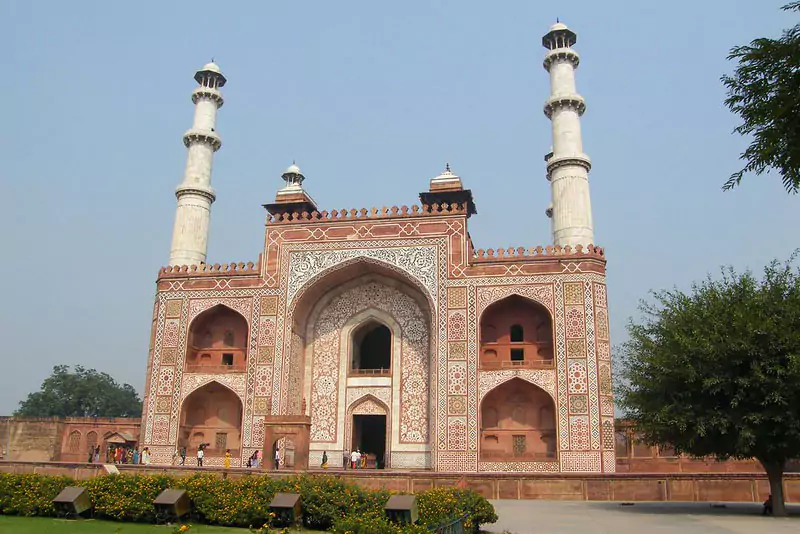
This mausoleum is the final resting place of Akbar, with his tomb located inside a quiet and dimly lit chamber. Surrounding the tomb is a beautiful Mughal garden designed in the traditional Charbagh style, which enhances the monument’s grandeur and sense of harmony.
Itimad-ud-Daulah: Agra’s “Baby Taj”
The Itimad-ud-Daulah’s tomb, often called the “Baby Taj,” is a stunning and delicate example of Mughal architecture crafted entirely from white marble. Built between 1623 and 1628 by Empress Nur Jahan in memory of her father, Mirza Ghiyas Beg, this mausoleum is renowned for its intricate latticework, beautiful colorful stone inlay, and perfectly designed Mughal gardens.
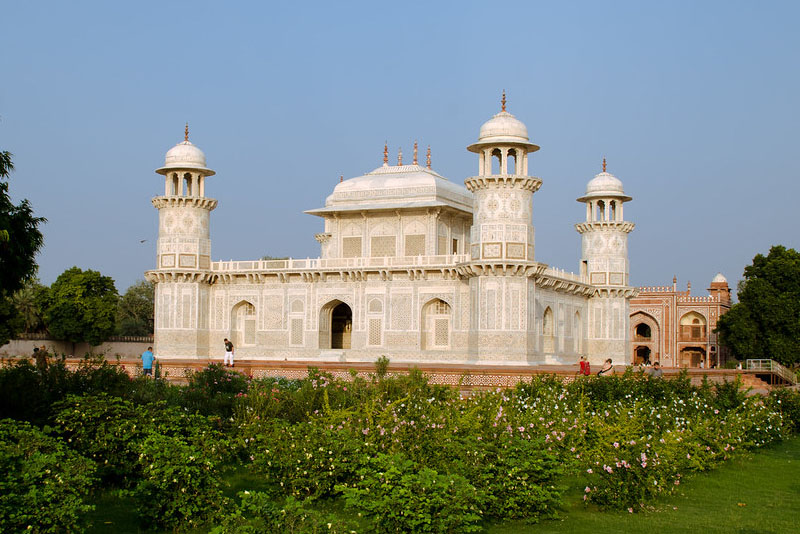
Often regarded as a precursor to the Taj Mahal, Itimad-ud-Daulah’s exquisite craftsmanship and pure elegance leave every visitor spellbound. It’s a must-visit for those who appreciate the finer details of Mughal artistry.
Chini Ka Rauza: A Marvel of Persian Art
Located just 1 kilometer from Itimad-ud-Daulah, Chini Ka Rauza is a unique and lesser-known yet exceptionally beautiful mausoleum. It was built in memory of Afzal Khan Mullah, Emperor Shah Jahan’s prime minister and a renowned Persian poet.
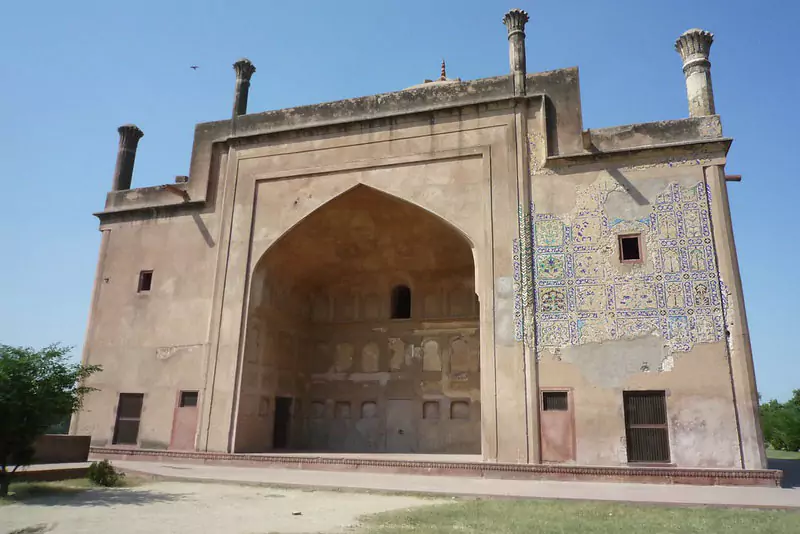
The monument is famous for its striking exterior adorned with glazed blue tiles made of “chini mati” or porcelain, believed to have been imported directly from China. Although many of these tiles have worn away over time, some sections still showcase this distinctive blue tilework. Inside, the floral murals exemplify exquisite Persian artistry.
Nestled amidst serene and lush gardens, Chini Ka Rauza remains open to visitors daily from sunrise to sunset, offering a peaceful retreat and a glimpse into Mughal-era Persian influences.
Tomb of Mariam-uz-Zamani: A Memorial to the Mughal Queen
This unique mausoleum, built of red sandstone, honors Mariam-uz-Zamani, the wife of Emperor Akbar. It is located near Fatehpur Sikri, about 1 kilometer from Akbar’s tomb, close to the Delhi-Agra National Highway. Originally known as Heer Kunwar, a Rajput princess, she was renamed Mariam-uz-Zamani after marrying Akbar in 1562. She was the mother of Akbar’s son and successor, Emperor Jahangir.
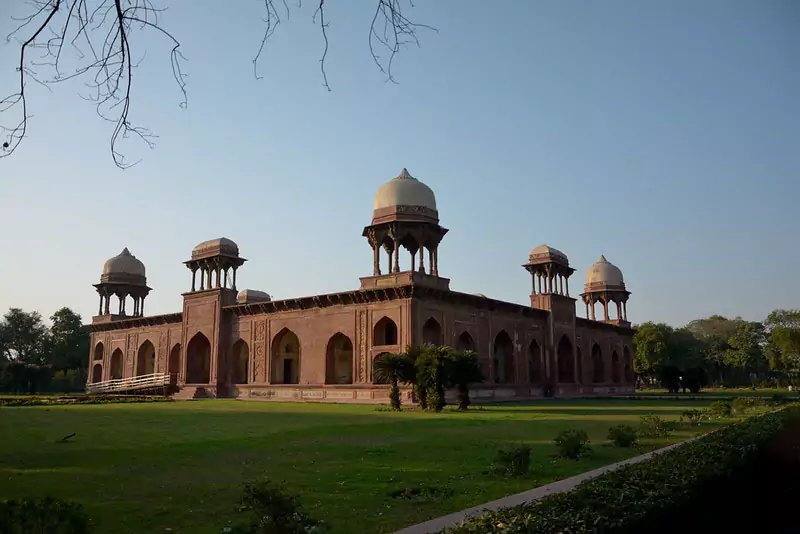
After her death, Mariam’s tomb was commissioned by Jahangir in 1623 near Sikandra. The monument features exquisite carvings and distinctive architectural design. The lower floor consists of nearly forty rooms built by Sikandar Lodi, with remnants of ancient paintings still visible on the walls. At the heart of the tomb lies Mariam’s cenotaph (symbolic tomb).
The exterior is adorned with red sandstone panels decorated with intricate geometric patterns. Each corner of the tomb is marked by octagonal towers topped with elegant pavilions supported by slender pillars. The upper floor houses an open marble cenotaph, which remains under the open sky.
Ram Bagh: Agra’s Oldest Mughal Garden
Ram Bagh is the oldest Mughal garden in Agra, commissioned by the Mughal emperor Babur. It is located approximately 3 kilometers from the tomb of Itimad-ud-Daulah and about 500 meters from Chini Ka Rauza.
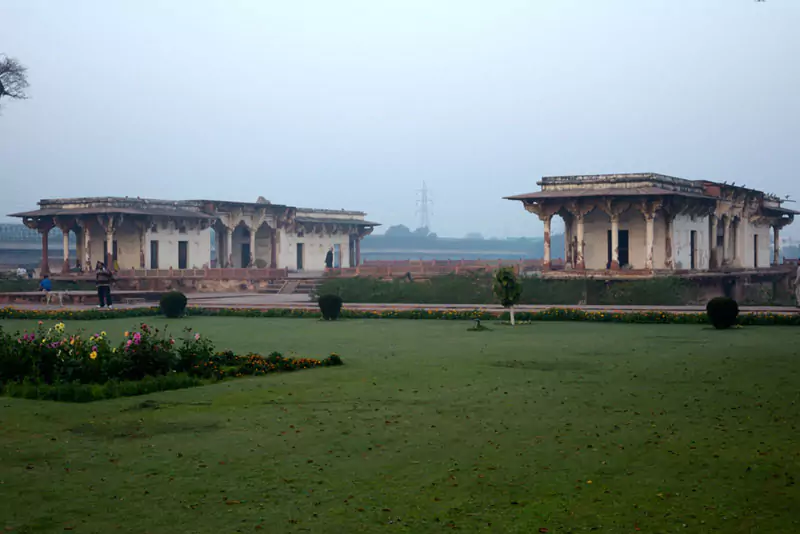
Established in 1528, this garden is a peaceful and lush green oasis amidst a bustling market area. It is believed that Babur was temporarily buried here before his final resting place was prepared in Kabul, Afghanistan. Later, Nur Jahan, the wife of Emperor Jahangir, renovated and restored the garden.
Nagina Masjid: The Beautiful White Marble Mosque
Nagina Masjid is a stunning mosque located inside Agra Fort, near the famous Moti Masjid. Entirely built of white marble, its prayer hall is exquisitely designed, reflecting the elegance of Mughal architecture.
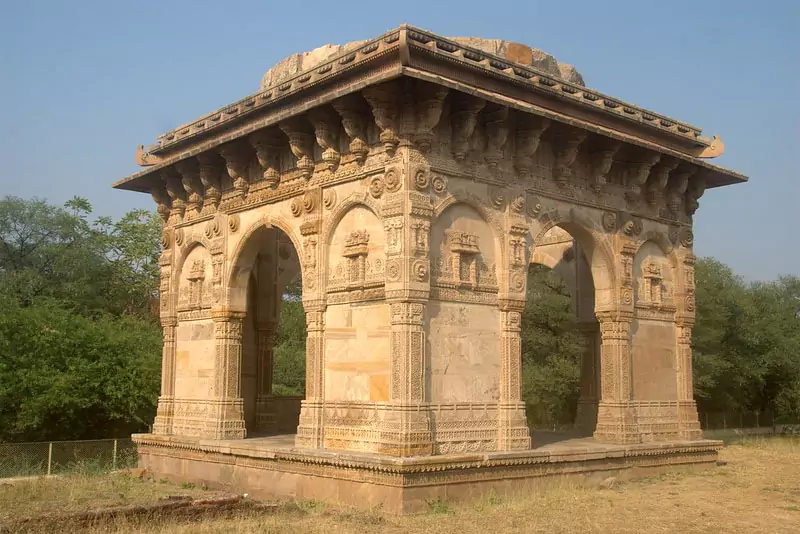
The mosque is situated at the northwest corner of the Machhi Bhawan within Agra Fort and was built for the private use of the emperor. It features a marble courtyard enclosed on the north, south, and east sides by walls, with the prayer hall located on the west side.
The prayer hall, also made entirely of marble, is topped by three domes. The mosque’s façade showcases three arches supported by slender pillars. The central arch is larger and adorned with nine pointed cusps (kaskusis), while the two flanking arches each have seven cusps, giving the mosque an exquisite and delicate appearance.
Mehtab Bagh
Mehtab Bagh is located on the left bank of the Yamuna River, directly opposite the Taj Mahal. This garden was originally built by the Mughal emperor Babur and is the last in a series of eleven gardens along the riverbank. The garden is square-shaped, measuring approximately 300 by 300 meters (980 by 980 feet), perfectly aligned with the Taj Mahal right across the river.
Excavations have revealed a large octagonal pond at the center of the garden and a gateway on its northern wall. Today, Mehtab Bagh is considered one of the best spots to view the Taj Mahal, especially at sunset, when the scenery becomes truly enchanting.
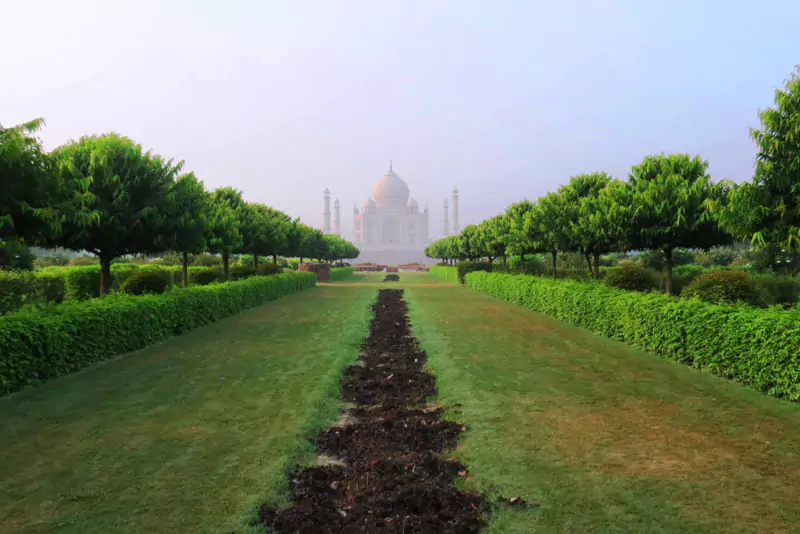
Jama Masjid
Agra’s Jama Masjid is one of the largest mosques from India’s Mughal era. It features a spacious rectangular courtyard and was built in 1648 AD by Shah Jahan’s daughter, Jahanara Begum. The mosque’s architecture reflects the Persian (Iranian) style and is constructed using red sandstone and white marble.
Approximately 5,000 workers were involved in its construction, which took six years to complete. Jama Masjid stands as a remarkable example of Mughal architectural brilliance and is a must-visit site for travelers interested in history and culture.

Guru Ka Taal
Guru Ka Taal is a prominent Gurudwara in Agra, known for its religious and historical significance. Construction of this sacred site began in the 1970s. It is believed that four of the ten Sikh Gurus visited this place, making it a revered pilgrimage destination.
Every year, the Gurudwara attracts a large number of devotees and tourists who come to pay their respects to the Sikh Gurus. Architecturally, Guru Ka Taal is considered one of India’s magnificent marvels, featuring intricate stone carvings and an impressive design.
This holy site invites travelers from far and wide to experience its spiritual ambiance and architectural beauty.
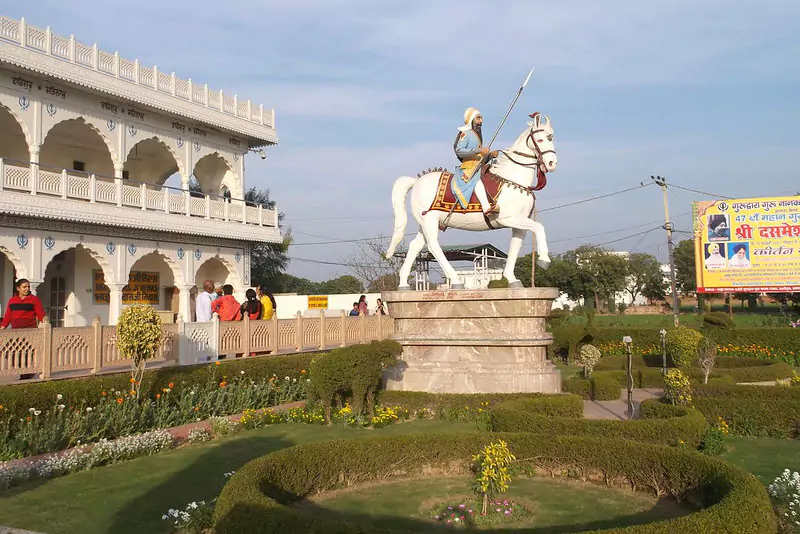
Must-Try Foods in Agra
Agra’s Famous Petha (Sweet)
Agra is renowned for its special sweet called Petha, made from white pumpkin (ash gourd). Petha comes in a variety of flavors and forms. There are two main types — a dry, chewy variety and a soft, syrupy one. Popular versions include plain (white), saffron-flavored, anguri petha, and paan (betel leaf) petha. Besides being delicious, petha is believed to have health benefits like helping with blood pressure, hydration, and brain development. For authentic and high-quality petha, visit Panchhi Petha near Hari Parbat Crossing.
Dalmoth
Dalmoth is a traditional savory snack made with nuts, spices, lentils, and oil. It is crispy, spicy, and slightly oily, making it a perfect crunchy treat with tea. Some of the best dalmoth can be found at Panchhi Petha and in Baluganj. It is also available in packets, making it a great snack to take home.
Bedai and Jalebi
Bedai is a popular breakfast dish in Agra, usually found at street stalls. It is a delicious mix of spicy and sweet flavors, comprising two parts: spicy bedai and sweet jalebi. Bedai is a deep-fried, puffed bread similar to kachori, served with spicy potato curry and yogurt. Jalebi is made from fermented batter fried and soaked in hot sugar syrup. This balanced breakfast is widely available across the city. For tasty bedai and jalebi, try GMB and Shri Ji Sweets on Fatehabad Road.
Paratha
Paratha is a well-loved Mughlai breakfast dish in Agra. Mostly vegetarian, parathas are wheat flatbreads stuffed with fillings like potato, cauliflower, carrot, or paneer, then pan-fried to perfection. They satisfy traditional Indian flavor cravings and are usually served with yogurt, pickles, and chutney. For some of the best parathas in Agra, visit Rambabu Paratha on the old Delhi-Agra highway.
Mughlai Cuisine
Mughlai cuisine reflects the rich legacy of the Mughal era, featuring creamy, spicy meat curries cooked with dry fruits and aromatic whole and ground spices. Though Mughlai dishes have spread throughout North India, Agra remains one of the best places to taste the authentic flavors. When the Mughals made Agra their capital in the 16th century, they deeply influenced the local cuisine. For genuine Mughlai meals, head to Nai Ki Mandi (MG Road), Indiana, Pinch of Spice, and Taj Mahal Restaurants on Fatehabad Road.
Chaat
Chaat is a popular street food in Agra offering travelers an explosion of flavors. Specialties include dahi bhalla, raj kachori, samosas, and gol gappe (pani puri). Agra’s dahi bhalla is unique — crispy fried potato and chickpea patties topped with grated ginger and sweet-tangy tamarind chutney. The bhallas here are large and crunchy, making the experience even more delightful. For the best and freshest chaat, visit the chaat lane in Sadar Bazaar. This flavorful street food experience is a must for every traveler exploring Agra.
Traditional Festivals and Cultural Celebrations of Agra
Taj Mahotsav
Taj Mahotsav is Agra’s most famous annual festival, held for 10 days every February. Organized by the Uttar Pradesh Tourism Department, this vibrant event provides a platform for traditional artists and craftsmen to showcase their skills. The festival features a rich display of India’s diverse arts, crafts, cultural colors, regional cuisines, and customs. Local performers entertain visitors with traditional music and dance. For children, camel and elephant rides are a major attraction. The festival celebrates the arrival of spring with grandeur, beginning with a spectacular procession of decorated camels and elephants. Artisans from across India participate, including Lucknow’s chikankari embroidery, Bhadohi’s handmade carpets, Saharanpur’s woodcarvings, and many more. Visitors can also witness Khurja’s famous pottery, Banarasi silk sarees, Rajasthan’s Sapera dance, Uttar Pradesh’s Nautanki theater, and Maharashtra’s Lavani dance.
Bateshwar Fair
Located about 70 km from Agra, Bateshwar is a small town famous for its 108 temples dedicated to Lord Bateshwar Mahadev (Shiva). The Bateshwar Fair is held annually during October-November and lasts for nearly a month. Devotees take holy dips in the Yamuna River during this period. The fair also includes a large livestock market where animals and cattle are traded. This event attracts pilgrims and visitors from Agra and nearby regions, making it a vibrant spiritual and cultural gathering.
Ram Baraat
The Ram Baraat festival is celebrated every year just before Dussehra, commemorating Lord Ram’s wedding procession. It is part of the larger Ramleela festivities that culminate on Dussehra, marking the burning of Ravana’s effigy. At the event venue, ‘Janakpuri’—depicting Sita’s palace—is beautifully decorated to welcome the procession. The colorful and elaborately adorned tableaux are the highlight of this grand parade. Large crowds gather to witness the wedding scene, where statues of Lord Ram and his brothers, adorned with jewelry, are placed on chariots and paraded through the streets.
Kailash Fair
The Kailash Fair is held at the Kailash Temple located on the outskirts of Agra, dedicated to Lord Shiva. This fair usually takes place in August or September and symbolizes the auspicious viewing of Lord Shiva in the form of a ‘lingam.’ Devotees from Agra and neighboring areas come in large numbers to participate in the fair, making it an important religious event in the region.
Unique Experiences to Enjoy in Agra
Sunrise and Sunset Views of the Taj Mahal
The most breathtaking view of the Taj Mahal is at sunrise. During this time, the crowds are minimal, and the cool, pleasant air makes it easier to fully appreciate the monument’s exquisite beauty. Watching the Taj Mahal glow in the soft morning light is truly magical. Sunset is another memorable time to visit, as the white marble monument takes on a warm, golden hue, creating an unforgettable experience.
Full Moon Night Visits to the Taj Mahal
It is said that on full moon nights, the moonlight makes the Taj Mahal sparkle in a way that cannot be seen in daylight. This mesmerizing sight attracts many visitors who wish to witness its ethereal beauty. The Taj Mahal is open for night viewing on five nights around the full moon each month. Tickets for these special visits must be purchased only one day in advance, and entry is limited to a fixed number of visitors.
Taj Nature Walk
Agra offers several vantage points from where you can admire stunning and artistic views of the Taj Mahal. One popular spot is about 500 meters from the eastern gate road of the Taj. This lush, beautifully maintained 180-acre garden features 20-foot-high towers that provide spectacular panoramic views of the Taj Mahal. Visiting during sunrise or sunset is ideal to fully enjoy the captivating vistas of this iconic monument.
Historical and Natural Attractions Around Agra
Fatehpur Sikri
Located 37 kilometers west of Agra on a rocky hill, Fatehpur Sikri was established centuries ago by Emperor Akbar as a symbol of his victories. The site is renowned for its stunning red sandstone architecture and intricate carvings, offering visitors a dreamlike journey into India’s rich historical past.
Mathura
About 49 kilometers from Agra, Mathura is the birthplace of Lord Krishna. The city is home to numerous magnificent temples that depict various phases of Krishna’s life, providing devotees and travelers alike with a spiritual and divine experience.
Sur Sarovar Bird Sanctuary
Away from the hustle and bustle of the city, this beautiful bird sanctuary is located just 26 kilometers from Agra. It is especially popular during the winter months when migratory birds arrive, making it an ideal spot for nature lovers and bird watchers to enjoy the serene beauty of the natural environment.






